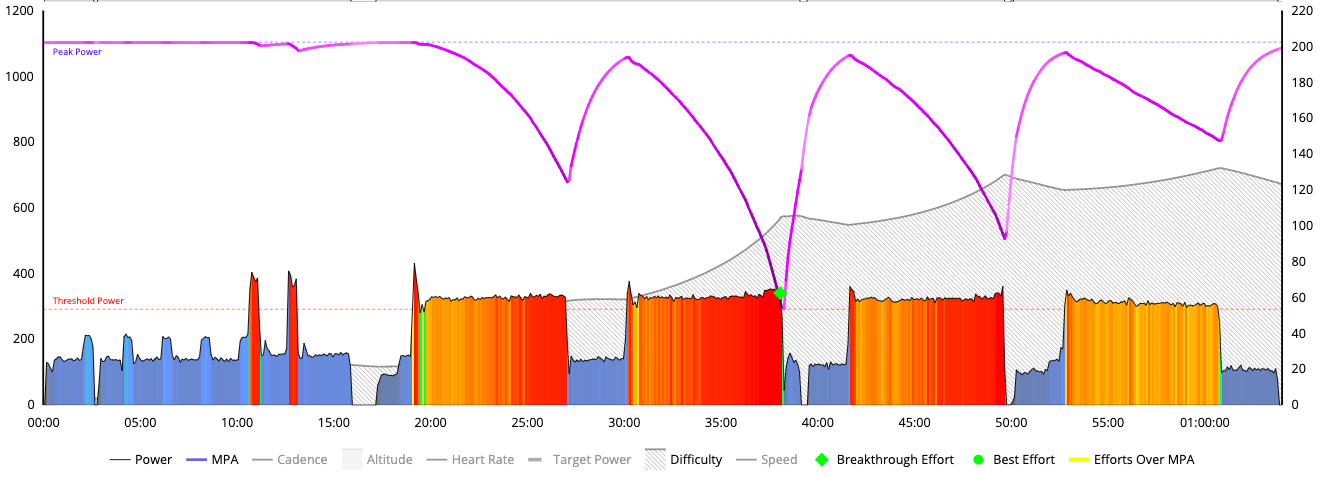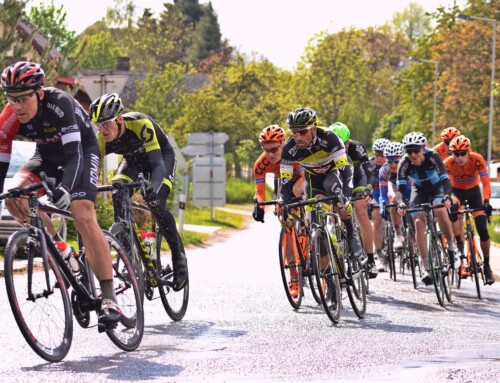Introduction
In a previous post, we looked at how the body responds to the demands of cycling by tight regulation of metabolic pathways: aerobic respiration, anaerobic glycolysis, and phosphocreatine. In this article, we’re going to expand on that thought and show how we can manipulate our training to enhance our metabolic machinery. We’ll begin with a discussion of how work performed relates to Xert’s quantification of strain, then discuss how our bodies respond to this strain, and finish with a discussion on adaptations to training.
Energy Systems and Focus/Strain
Strain is a direct result of exercise. Xert quantifies this strain as work performed relative to Maximum Power Available (MPA) measured in kJ’s, and then normalizes it to every athlete’s fitness signature to obtain the Xert Strain Score (XSS). This strain is subdivided into low, high, and peak strain, depending on the relative intensity of the work.
Sports scientists have long been interested in studying the effects of manipulating both the intensity and duration of exercise in order to optimize adaptations and performance. Typically, time and a measure of average power are used to describe time and intensity, respectively. However, by looking at power and MPA, we can look to quantify strain since work can be evaluated in the context of MPA. By then subdividing that strain into low, high and peak strain, we can determine the Focus of the strain generated, aggregating each second into activities, training blocks and even seasons, by evaluating their ratios of contribution. Focus Duration and Specificity Rating provide an easy way to interpret which systems are being stimulated by using the ratios of strain contribution and comparing these to the ratios that are associated with different durations on the Power Duration curve (see Figure 1 in The Science: Metabolic Pathways and How They Affect Your Riding and Racing).
In the following figure, you can see how manipulating the distribution of low, high, and peak strain results in differing Focus Durations. Low intensity endurance activities are comprised of almost exclusively low strain, while high intensity activities include significant amounts of high & peak strain. The proportions of low, high, and peak strain are directly related to the Focus Duration of the activity, as shown in Figure 1 below.

Fig 1. Differences in the ratio of accumulated strain directly relate to the Focus Duration of the activities. Greater contribution from high/peak strain results in a lower Focus Duration. For example, the Focus Duration of the highlighted activity on the left was 03:45, while the focus of the highlighted activity on the right was –:–.
Notice that the height of the bars from Figure 1 are based only on strain, and are independent of time. Thus, it is possible to provide similar total amounts of strain in a shorter workout. This notion is supported in the literature by the rising popularity of low volume, high intensity interval training (HIIT) and sprint interval training (SIT) over traditional high-volume endurance training (McInnis & Gibala, 2017). Xert’s calculations of strain reinforces this evidence, and even pushes the idea a little farther, since the strain rate for a given power output can be increased by first decreasing Maximum Power Available (MPA). This means that performing intervals under fatigue leads to accelerated accumulation of strain, and arguably, physiological adaptations.
How The Body Responds To Strain
The physiological strain from exercise results in adaptations, both physical and biochemical, including increases in capillary density, recruitment of new mitochondria, and increases in metabolic enzymes.
Several researchers have attempted to determine the relationship between exercise intensity/duration and the physiological adaptations they induce. In a study published in 2013, Stephen Seiler and colleagues wanted to investigate the impact of interval length on increases in performance. A control group performed all moderate intensity endurance training, while the other cyclists were divided into 3 groups that performed either 4×4 minute, 4x8min, or 4×16 min intervals with 3 minute recoveries between intervals. Intervals were performed at maximal sustained effort, or isoeffort. All groups performed these HIIT sessions twice weekly in addition to 2-3 low intensity workouts for 7 weeks. The investigators measured the changes in key physiological variables, including VO2max and power at 4mmol/L lactate (a physiological estimate of Threshold Power). What did they find?
All groups of cyclists observed increases in both VO2max and power at 4mmol/L lactate. However, they found that the greatest increases were observed in the group that performed 4x8min intervals. It should be noted that, in this study, the exercises were matched for effort, not for total work performed. Therefore, the results suggest that 4×8’s provided the largest gains for a given level of effort.

Fig 2. Increase in VO2peak and Power at 4mmol/L (TP) following 7 weeks of training. Notice that although all groups improved, the 4×8 group observed the largest increases. Seiler, et al., 2013.
When replicating the 4x8min style workout in Xert, we see that each interval results in drawing down MPA, exponentially increasing the strain rate as each interval progresses. However, the intervals were just long enough to prevent a large amount of time being spent at or near MPA. In 4×16’s the strain rate is lower, since each interval is performed around Threshold Power, which does not pull down MPA. On the other hand, 4×4’s were found to be very difficult to complete – Seiler’s group reported that rate of perceived exertion was significantly higher for participants completing the 4×4 protocol. Thus, the 4×4’s also did not allow a large amount of time to be spent near MPA, and the adaptations following the training intervention were similar to the group that performed 4×16’s.

Fig 3: Personal experience with the 4×8 protocol. It is best to perform these in slope mode or on the road, so that you can control the power output through shifting and cadence. Notice that even as power decreased slightly during each set, the strain rate still increased. The focus of this entire activity was 11:50 (or a ‘Climber’ Athlete Type). The last two intervals saw an increase in central fatigue making them difficult to complete.
Another researcher, Dr. Rønnestad, wanted to investigate the varying effects of short vs. long duration intervals. In their 2015 paper, the investigators divided participants into 2 training groups: a short interval group and long interval group. The short group performed 3 sets of 9.5 minute intervals consisting of 30s work intervals and short 15s recoveries, with 3 min recoveries between sets. The long interval group completed 4x5min intervals with 2.5min recoveries – similar to Seiler’s 4×4 protocol. Intervals were to be completed at each participant’s maximal sustainable work intensity, aiming to achieve the highest average power output possible (isoeffort). These high intensity sessions were completed twice weekly for 10 weeks.
What did they find? The primary finding was that superior adaptations were observed in the group that performed high intensity training using short intervals, despite similar effort and work duration between groups. Furthermore, the short interval group observed increases along several points of the power-duration curve, including a 30s Wingate, 5 min all-out, and 40 min all-out time trials.
Once again, it should be noted that the groups were not matched on total work performed, but were matched by effort instead. Part of the explanation for why the short group may have seen larger fitness gains was that short intervals have been shown to elicit a higher amount of time spent above 90% VO2max (Rønnestad & Hansen 2016). Additionally, the 2:1 work to rest ratio has also been shown to increase the time spent above 90% VO2max when compared to a 1:1 work to rest ratio (Rozenek, et al, 2007).

Fig 4. Increases in VO2peak and power at 4mmol/L lactate (analogous to TP) for both the short interval and long interval groups following the 10 week intervention period. Ronnestad, et al., 2015.
When replicating the 30/15 protocol with Xert, the analysis shows that short intervals are a highly effective potent stimulus because one can complete large amounts of work near MPA. The micro-rests allow just enough recovery in between reps to continue putting out suprathreshold power. However, it is essential to attempt these workouts when fresh in order to perform them well and to get the most out of these workouts. Other examples of highly effective short intervals include Tabatas (20/10’s), 30/30’s, and 15/15’s.

Fig 5: Personal experience with Rønnestad’s 30/15 protocol. Notice that the difficulty of this activity is much higher than 4×8’s, since a large amount of work is being performed near MPA. The focus of this activity was 3:52.
Notice that although both activities were approximately 1 hour long, the short intervals resulted in a slightly higher strain score (144 vs 135 XSS), even though less total work was performed (782 vs 884 kJ). Here we can see that the math behind Xert supports previously published results in the scientific literature. It also shows the importance of understanding strain and focus, and how they are affected by manipulating the intensity and duration of work and rest intervals.
Relationship to Fitness Signature
Skeletal muscles are divided into three categories: fast-twitch type IIa, fast-twitch type IIb, and slow-twitch type I, which are consistent with the three parameters of your fitness signature (PP, HIE, and TP, respectively). Athletes have varying capabilities to perform aerobic, anaerobic and neuromuscular exercise, based partially on their muscle fibre distribution, capillary supply to the muscle, mitochondrial density, and partially upon maximal oxygen consumption.
Athletes that have a higher distribution of fast-twitch fibres generally tend to have relatively large Peak Power/High Intensity Energy values (cyclists like Chris Hoy or Elisa Longo Borghini). In contrast, slow-twitch athletes will generally have a fewer fast twitch fibres, and relatively lower PP/HIE values (Chris Froome or Marianne Vos). These differences manifest themselves in Xert’s measure of Lower Threshold Power, where LTP is inversely related to HIE.
Because some riders have recruited enzymes to more efficiently burn carbohydrates and produce large amounts of work anaerobically, they are less suited to utilize fats – even at sub-threshold power outputs. Conversely, aerobic athletes have superior adaptations in mitochondrial density and aerobic enzymes, meaning that they are capable of riding relatively closer to threshold while still staying predominantly aerobic/fat burning. The thought is that aerobic athletes – especially cyclists – will do their best to conserve glucose for those key moments in races, like establishing breakaways, final sprints, etc. Thus, the driving force behind training for many athletes is to increase their body’s ability to sustain work aerobically.
How To Train Your Fitness Signature
The studies quote above are insightful, but how do we apply these results to your training? The Xert Adaptive Training Adviser guides you through a 120 day training cycle, broken into 4 phases: base, build, peak, and taper. As you work through your base phase, the advisor will guide you to increasing your low training load by predominantly recommending workouts with and Endurance Focus. This is a crucial step in the training cycle, since your low intensity training load takes the longest to increase and requires the most training investment in terms of time. There are no shortcuts to increasing your low intensity fitness without increasing the volume of your training but it is an important step because high and peak strain can only be accumulated with a good foundation of low strain. If your body is not in good aerobic condition, it will be hard for you to accumulate high & peak strain.
After building a deep base and you will enter build & peak phases, and the recommended high intensity workouts will change from endurance workouts, to workouts with progressively shorter Focus, eventually recommending workouts of your chosen Athlete Type/Focus as your target event date approaches.
In Xert, the ‘low’ energy system is trained through low and moderate intensity exercise (below Threshold Power and even below Lower Threshold Power). The high energy system is best trained by repeatedly drawing down MPA with, for example, micro-intervals or intervals at a rider’s 3-5 minute power (these workouts often have a Rouleur, Breakaway Specialist, or Puncheur Focus when the warm-up and warm-down are accounted for). The intervals in these workouts are often called ‘VO2max intervals’. Finally, the peak energy system is best improved by accumulating peak strain (< 6 second, max power sprints) with only light riding between sprints.
If you’d like to learn more about the information provided in this article, you can consult these published scientific articles:
Seiler S, Jøranson K, Olesen BV, Hetlelid KJ.. Adaptations to aerobic interval training: interactive effects of exercise intensity and total work duration. Scand J Med Sci Sports. 2013;23(1):74-83.
Rønnestad BR, Hansen J, Vegge G, Tønnessen E, Slettaløkken G. Short intervals induce superior training adaptations compared with long intervals in cyclists – an effort-matched approach. Scand J Med Sci Sports. 2015 Apr;25(2):143-51.
Rønnestad BR, Hansen J. Optimizing Interval Training at Power Output Associated With Peak Oxygen Uptake in Well-Trained Cyclists. J Strength Cond Res. 2016 Apr;30(4):999-1006.
Rozenek R, Funato K, Kubo J, Hoshikawa M, Matsuo A. Physiological responses to interval training sessions at velocities associated with VO2max. J Strength Cond Res. 2007 Feb;21(1):188-92.
MacInnis MJ, Gibala MJ. Physiological adaptations to interval training and the role of exercise intensity. J Physiol. 2017 May 1;595(9):2915-2930. doi: 10.1113/JP273196. Epub 2016 Dec 7.




